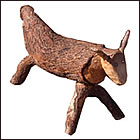 |
| 18th century engraving |
The Catalan Tió (or shitting log) is a tradition
which congregates -on December 25th- thousands of families
around a log or “soca” called Tió, preserving thus a rite which
probably had its roots in ancient Indo-European tree worship.
The Christmas or Winter
solstice Tió (which is an ancient Catalan word for “big log”) is
firstly documented in Catalonia in the 17th century,
though it has always claimed to be much older. This type of
celebration is very similar to other tree worshipping rites as the
Yule log in the Germanic territory, even though it can be different
sometimes. Anyway, the Tio was made of oak wood, a typical sacred
tree from the Indo-European tradition linked to fertility.
Nowadays, the ritual goes
like this: the Tio is decorated with a face, wears a hat and smokes a
pipe. Once placed at home, it is fed with seasonal fruit and covered
with a blanket. The fruit disappears -parents hide it- and kids think
the Tio is eating it. On the night of December 24th,
parents put small gifts and sweets under Tio's blanket. Next morning,
kids hit the Tio with canes, whilst singing a song. They take off the
blanket and find the hidden sweets.
The song goes like this:
Caga tió -shit tió-
ametlles i torró -almonds
and nougat
no caguis arangades -do
not shit mackerels
que són massa salades
-they are too salty
caga torrons -shit nougat
que són més bons
-which are really nice
Caga tió -shit tió
ametlles i torró -almonds
and nougat
si no vols cagar -if you
don't want to shit
et donaré un cop de bastó
-with my cane you will be hit!
But the primeval rite was
not that innocent. In the past, it was known that the log was burnt
in a fireplace from the day of the winter solstice until Epiphany day
(January 5th). Its ashes were used for household remedies
and as a talisman for protection. All this symbolised the eternal
renewal of the seasonal cycle. The food and prayer offerings
perpetuated the ancestor worship, and enhanced the preservation of
the family nucleus, and its flame evoked the solar light, now almost
gone. In fact, this ritual was attacked by the Braga bishop in the
7th century. In the French Provence there existed a
variation of the rite in which the family walked thrice around the
house carrying the log, and finally poured wine on it and recited a
prayer.
Celebrations around a log
are not just exclusively found in Catalonia, as it has been said,
they are a reminiscence of the tree worshipping traditions that
guaranteed the community health and prosperity. At the same time,
they were a way to worship the ancestors and the family name. It has
been claimed that the Tio is just a re-formulation of the Germanic
Yule Tree, and it is quite possible, as its presence in Catalonia
precedes the arrival of this tradition, and it has always been seen
as something typical from our lands.
Unfortunately, the Tió
cannot compete with the Yule tree from the Germanic (Norse also)
tradition, and I assume that, if it is not preserved, it will be lost
in a couple of decades. I thinks this is something to remember:
though it has now been infantilised and made quite childish, the Tio
was our original Yule Tree, our link to Sacred Nature.
Enciclopedia de la
fantasia Popular catalana – Joan Soler i Amigó
Imágenes de Wikipedia.


Cap comentari:
Publica un comentari a l'entrada